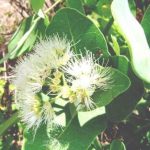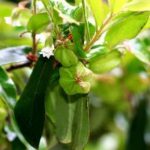TREE LIFE
November 2000
As before please confirm with any of the committee members that the scheduled outings and walks will actually take place. See back page for numbers.
On Sunday 22nd October a very special member of the Tree Society turned 90 years of age. Barbara Tunney who held the position of treasurer in the early 1960’s still attends some of our activities. Congratulations and love from us all Barbara.
MASHONALAND CALENDAR
Tuesday 7 November. Botanic Garden Walk. Meet in the car park of the Botanic Garden where we will meet Tom at 4.45 for 5 p.m.
Sunday 19 November. Our hosts this month are Rob and Val Wood in the Trelawney district. Directions: Take the Lomagundi road out of Harare and follow this over the Dyke. Cross the railway line on the north side of the Dyke, and approximately one kilometre beyond this turn left to Trelawney at a well-marked crossroads. Continue to Trelawney along the narrow tar and watch out for potholes. The distance is approximately 15 km. At Trelawney turn left into the Darwendale-Banket road for 200-300 metres, pass the service station on your left, and then turn left onto a dirt road signposted ‘Sable Valley Road’. Pass the Post Office on your right, and continue for 5-6 km to sign posts reading ‘Rob & Val’ and Dom & Mandy Couve’. Turn left and continue for 1-2 km to the farm complex, plastic-covered rose sheds on your right. Continue a little beyond this, and you will be shown to a parking area on arrival. Distance from Harare approximately 95 km.
DO NOT be tempted to travel via Darwendale because this road is very bad. Bring your lunch and a chair and meet at 9.30 a.m.
Saturday 25 November. Mark’s Walk is to Bill Clark’s lovely property Val D’Or in the Arcturus area.
Sunday 3 December. This is a combined Christmas social and sadly our official farewell to the Haxen family who will shortly be emigrating to Oz. By popular request Tree Bingo will be played amongst the more than 120 tree species growing at “The Shambles” Although this will be Phil’s ‘swan song’ as MC he will still resist obvious bribes.
Tuesday 5 December. Botanic Garden Walk.
MATABELELAND CALENDAR
MATABELELAND CALENDAR
Sunday 5 November. To the Herbst’s farm at Nyamandhlovu to look at Sesamothamnus and Commiphora. We meet in the car park at Girls’ College for a prompt departure at 8.30 a.m.
Sunday 3 December. Weekend at Kana? In all cases please contact a committee member for confirmation.
BULAWAYO BRANCH OUTING
SEPTEMBER 3rd – NUST CAMPUS
SEPTEMBER 3rd – NUST CAMPUS
Being unable to contact anyone on the phone (The PTC in their total disregard for the subscribers has changed all the numbers that started with 4 without notice) and despite the fuel shortage as well as the new prices a handful of us gathered at Girls’ college at the appointed time. Having waited the 15 academic minutes, and adding some to (compensate for the vagaries of Zimbabwe standard time, Jean suggested that we should proceed and make a reconnaissance of the campus.
Past the main gate and driving up the impressive double boulevard leading to the main complex, our first stop was by a mostly leafless acacia.
Clues not being terribly abundant out came Jonathan’s Book of Wisdom:
Are the thorns paired at the node?
Amen.
Are the thorns straight?
Amen.
Are the thorns longer than 6 cm?
Amen.
Are the inflorescences globose?
We think so.
Are the pods woody?
A lone pod needed an act of faith.
Is the soil rocky?
Amen
Are the leaves tufted at the nodes?
Sort of looks like it
Have the leaves got 2 to 4 pinnae?
New growth too minute to see.
The litany attracted the attention of one of the guards who found our ritual very perplexing. From then and from a respectful distance he kept a watchful eye on us. His report must have read something like this:
Nuts at NUST revive the Cult of Ceres.
On that part of the campus we noticed a variety of acacia species, including Acacia nigrescens, Acacia robusta, Acacia galpinii, Acacia gerrardii, Acacia karroo, Acacia sieberiana and Acacia rehmanniana. The Acacia galpinii are particularly striking this time of the year covered in their red coat prior to the explosion of the cream spikes of the flowers.
Past the main complex we stopped in a variety of spots. A specimen, victim of the last frost, next challenged our Hercule Poirot instincts. This time we called Meg’s Magic to the rescue and under the suspicious eye of the guard:
Are the leaves compound?
Amen – go to 2
Pinnately compound?
Amen – go to 3
Once pinnate?
Amen – go to 4
Imparipinnate?
Amen – go top 180
Are the leaflets……………….etc.?
Fortunately, Gill had found half a green leaflet, after many go back three spaces, do not pass go, do not collect $200.00, we got to Pterocarpus lucens.
The Commiphora were represented by species Commiphora mollis and Commiphora glandulosa. The Combretum should be represented by more than just the Combretum hereroense we noticed.
Of particular interest is a patch of Colophospermum mopane in the comer of the campus. New to our little group were a Tarchonanthus camphoratus, a Rhigozum brevispinosum, a Euclea undulata, an Ozoroa paniculosa and a Mundulea sericea.
We identified some 36 species but see that we only scratched the surface and that more visits are warranted.
NUST deserves congratulations on a beautiful campus and we hope that we were not incorrect in assuming that permission had previously been given to someone on the committee, we’d like to thank them for allowing us to enjoy their trees and look forward to being associated with any projects dealing with them.
-PJ FELU
TWO BUNDU RELATED PUZZLES
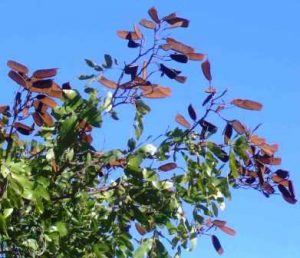
Julbernardia globiflora. Photo: Bart Wursten. Source: Flora of Zimbabwe
Some years ago I had the opportunity of flying over the Victoria Falls airport in a light aircraft with good visibility of the ground below. The airport is located on a ridge of deep Kalahari sand which, in its virgin state, supports strong deciduous ‘Gusu’ woodland, the main constituents of which are Erythrophleum africanum, Baikiaea plurijuga, Brachystegia spiciformis, Kirkia acuminata, Pterocarpus angolensis and Julbernardia globiflora.
Being late in the dry season, leaf shedding in the woodland was complete. However, from the air it was very noticeable that there was a narrow belt of trees distinctly still in leaf along the perimeter of the airfield where the indigenous woodland meets the cleared grassland. This belt was probably no more than ten meters wide and I found the phenomenon puzzling, especially as I considered it very unlikely that plantings of a non-deciduous species had been made along the whole perimeter. Furthermore, without a ground recce, I could only assume that there had been no significant natural change in the constituent indigenous tree species along the interface to account for the delayed leaf drop.
The more likely explanation was that the perimeter trees enjoyed enhanced water relations from the adjacent clearing. Doubtless, the roots of these edge trees had been able to extend into the cleared area to exploit the deeper moisture reserves not utilised by the shallower grass roots, which is characteristic of these deep Kalahari sands.
The second puzzling observation arose during a recent canoeing trip along the Zambezi between Mana and Kanyemba. At the start of this leg, the river is extremely wide but as the Mupata gorge is approached, it narrows sufficiently to make both banks clearly visible. After a few kilometres I became convinced that the Zimbabwean (south) bank had noticeably fewer trees than the Zambian (north) bank.
Normally such sharp transitions of vegetation are associated with changes in soil type but this is unlikely in this case because the soils adjacent to the river in this vicinity are mostly localized alluvial deposits and therefore unlikely to differ materially between the two sides. Rainfall, too, could not be expected to vary between the two banks, and any wind is directly upstream as canoeists soon realize!
One possible explanation for the seemingly fewer trees and greater denudation on the south bank arises from overstocking by wildlife and this may certainly have relevance in areas well back from the river, but it is not likely to be the case in the riverine fringe where the substantial population of hippos have free access to both banks for their nightly foraging. Elephant, too, I believe, wander at will from one side of the river to the other.
It seemed to me that the differing aspect, or angle, of the riverbanks to the sun was a more likely explanation in ecological terms. We all know that in high latitudes such as Europe, south facing slopes are generally sunnier and warmer. Even here in the southern hemisphere, although within the tropics, houses facing north are usually preferred as being sunnier in winter.
The latitude of this part of the Zambezi is 15° 40’S and the river orientation is west-east. The sun, in its annual migration northwards, crosses this area on about the 7th February, returning on the 4th November on its southward passage. The shorter midsummer period of about three months when the sun is to the south coincides with greater cloudiness and rain, which tempers any excess insolation in the valley generally, but for the remaining nine months of the year the sun is in the north and, being mostly cloudless, the north-facing Zimbabwean bank receives the full brunt of the sunshine, especially from September to November, making it the more barren of the two as a consequence of increased desiccation.
Nevertheless, there are many very fine specimens of trees to enjoy on the Zimbabwean bank as one paddles by in near silence, notably Faidherbia albida, Kigelia africana, Tamarindus indica, Cordyla africana, Trichilia emetica, Kirkia acuminata, Ficus sycomorus, Ziziphus mauritiana, and Diospyros mespiliformis. Well-grown mopane, Colophospermum mopane, is also common in places.
-John Wilson
UMWINSIDALE, Sunday 21 August 2000
With Mark away enjoying the delights of late summer in the UK and myself in a state of confusion, Meg Coates Palgrave very kindly stood in for the ‘missing’ leaders! This was the first Sunday outing for some months and it was really good to get back into something more normal.
UK and myself in a state of confusion, Meg Coates Palgrave very kindly stood in for the ‘missing’ leaders! This was the first Sunday outing for some months and it was really good to get back into something more normal.
The Umwinsidale area is interesting as it appears to be a contact zone with the eastern region vegetation, however, more of that later. The dominant woodland is Miombo, with Julbernardia globiflora (Mnondo) being dominant. If you are new to the game, this species is easily identified as the pods conveniently position themselves above the foliage and are noticeable. Slight coppery hues to the new foliage are apparent but are subtle compared to the glorious colours of Msasa in new leaf. Meg explained this colouring as the presence of anthocyanins form a sun block for new leaves. These pink leaflets are apparent throughout the growing season as small clusters on the terminal growth. The hue lasts for about 25 days.
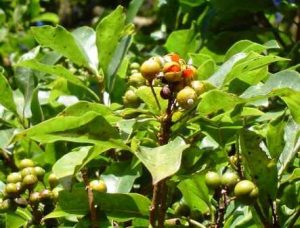
Pittosporum viridiflorum. Photo: Bart Wursten. Source: Flora of Zimbabwe
Pittosporum viridiflorum, another common resident around Harare, is easily identified by the hundreds of small brown specks (lenticels) on the otherwise mundane pale grey bark. Lenticels are a tree’s breathing apparatus and if you are uncertain of what they really look like, take a look at the younger branches on the Mulberry – Morus alba – they are very similar. Another species in this environment was Zanha africana, which is almost exclusively found in rocky terrain, as the thin bark has little resistance to fire. Distinct features are its bark flakes in elliptical patches leaving a red underbark and its leaf has two terminal leaflets, one being dominant while the other bends away slightly giving a lop-sided appearance. This is a feature of the family Sapindaceae.
As mentioned earlier, the east of Harare is a contact zone, with the unexpected sighting of the Bushman’s Poison Tree Acokanthera oppositifolia. A solitary plant in this case, although we have once seen a grove of these plants near Wedza. The scent emitted from the clusters of tiny white flowers reminded the gardeners in our midst of Honeysuckle, which was great news for the Hay fever sufferers! Another species more common in the eastern Districts is Heteromorpha arborescens, also known as the Parsley Tree. This species is also found in the higher zones of Christon Bank and has a distinctive deeply dissected leaf and, if you are lucky the remaining fruits are like that a parsley flower. A woody species that causes some puzzled head scratching and of late, irritation, is the Vernonia family. Mark has on many occasions shown us how to check the floral parts, the key being the presence of dark hairs on the pappus. Without a lens and perfect eyesight, forget it! So for the record, the tight buds and small stature of the plant was taken to be Vernonia adoensis.
Other more common species seen included Strychnos spinosa, sadly lacking in palatable fruit, a few Vangueria infausta, Terminalia stenostachya with obvious ‘craters’ at the bases of last year’s leaf growth and several Mukwa Pterocarpus angolensis. The curious fruit of the Mukwa sometimes referred to, as a ‘hedgehog in life raft’ is in fact a very tough product. Baboons seem to have mastered a way around the stiff spines but humans resort to pliers and leather gloves to break open the seed capsule. However, it seems immersion in boiling water for a few hours may be the answer!
As usual with so much to see and discuss, not much time was left to ready investigate the lower part of the property, which was mainly orchards, and in particular Macadamia nuts. Unfortunately, I had to slip off at lunchtime to prepare for my impending holiday in the UK. A superb spot and so conveniently close to town. Many thanks to Mick Fleet for showing us around and to Meg for standing in and conducting a most interesting walk.
-Andy MacNaughtan
In Retrospect – Lyn Mullin
NORMAN CENTLIVRES CHASE
In TREE LIFE No. 35 (January 1983) Paul and Meg Coates Palgrave published an appeal for private donations to mark the grave of Norman Chase, who died on 18 November 1970. In March 1970, Norman Chase’s great dream of a nature reserve at Murahwa’s Hill came to fruition, and he was honoured at a ceremony to unveil a plaque on a large boulder in the new reserve that he had worked so hard, and often alone, to create. It was stressed that the fund for Norman Chase was not an official activity of the Tree Society.
[Comment 2000: Norman Chase was born in 1888 in Uitenhage, South Africa, and came up to the then Southern Rhodesia to join a bank. He was based in Mutare, and at about the time of his retirement (1945) he set about becoming acquainted with the local flora, and collecting herbarium specimens in the Eastern Highlands and in Mozambique. He lived in the old Cecil Hotel, in an upstairs room with a balcony, and one of the commonest sights in Mutare in the 1950s and 1960s was his array of botanical presses, filled with specimens, set out to dry on the balcony. He had no car, and usually got a lift to wherever he wanted to botanize, perhaps staying out in the bush for several days at a time, and by 1960 he had collected more than 6 000 specimens, the first set going to the Southern Rhodesia Government Herbarium, a private set later presented to the British Museum, and other specimens sent to herbaria at Kew, London; Coimbra, Portugal; Lisbon, Portugal; St. Louis, Missouri, USA; and Pretoria, South Africa. Norman Chase’s collection was regarded as one of the finest made in this country during his time, and included species new to science, some of which were named for him. He never lost his strong South African accent, and some of his pronunciations of botanical names were quite startling! He was one of nature’s gentlemen, always quite emphatic that he was a collector, not a botanist, but the professional botanists of this country held him in very high esteem.]
SAPINDACEAE AND MUTINY ON THE BOUNTY
From a ROOTNOTE contributed by Dick Petheram in TREE LIFE No. 44 (October, 1983):
The interesting note in the August Newsletter concerning our July inspection, with Tom, of the Sapindaceae in the Botanic Garden, reminds me of the fact that the genus Blighia was named after Captain [William] Bligh of the Bounty. It was not, however, the plant that is reputed to have played so fateful a part in the Mutiny on the Bounty. That was the breadfruit plant, Artocarpus altilis (Moraceae), a consignment of which Capt. Bligh was taking from Tahiti to Jamaica, where food for slaves was short. During the voyage, drinking water became scarcer and scarcer, and the plants were given a better ration than the sailors. (Incidentally, the whole expedition was organized by Sir Joseph Banks, in whose honour the Banksia was named).
[Comment 2000: Joseph Banks (1743-1820) was the botanist attached to Captain James Cook’s expedition to Australia, and in 1770 Banks and his assistant, Daniel Solander, collected the first eucalypts specimens known to science. These were Eucalyptus gummifera and Eucalyptus platyphylla, but they were not the first to be named. In 1777, on Cook’s third expedition, David Nelson collected specimens of Eucalyptus obliqua off the coast of Tasmania, and it was this species that was given the generic name Eucalyptus.)In another ROOTNOTE in TREE LIFE No. 44 (October 1983), Kim Damstra wrote:
Another interesting comment on the Sapindaceae came from Wendy Bullock, once a pillar of the Matabeleland Branch, but now living in Chimanimani. It was exciting to learn that Erythrophysa transvaalensis was first recognized in the country from a specimen discovered by Alec Dry on a Tree Society outing to the lone baobab near Khami Ruins. Bob Drummond went to see this exciting tree full of ‘red balloon’ fruit. It transpires that an earlier collection from Double Cross Ranch, Gwanda, had not been recognized. Seed from this specimen is now growing in the Bullock’s old garden at 8 Chapman Road, Burnside. As these are the only known plants, my comment in TREE LIFE No. 421 on their being locally common should be deleted. Wendy added a further correction and note: “Pappea capensis was Lobengula’s (not Rhodes’s) Indaba Tree. As far as I know, the specimen at Government House (his 2nd Bulawayo) is still living. When we first went to Bulawayo 25 years ago there was a specimen at his original Bulawayo, already being strangled by a Ficus burkei, and has since completely disappeared, but the spot is marked by a commemorative stone on the roadside near the old Jesuit Mission”.
[Comment 2000: In March 1987 Lobengula’s Indaba Tree at State House, Bulawayo, was still alive, although there was much dead wood on it, and this was removed by some corrective pruning. There were also six healthy suckers growing from the tree’s roots, a hopeful sign that this historic tree will be with us for many more years. The fig that killed the Indaba Tree at Old Bulawayo is now named Ficus thonningii.]In Retrospect will continue next month
NYARUPINDA CATCHMENT 7th September 2000
The Scene
Often during the months of September and October there is no streak of dawn, the firmament is different. Deep red sun rises (and sets) in a dense grey-blue haze of smoke and dust in the atmosphere. Kopjies and ranges of hills on the Ayrshire district skyline are obscured. Winds from the northeast may be fitful or nearly gale force. It has not rained since April, bush fires occur, low visibility and white sky makes them difficult to detect. These weather conditions engender feelings of being hemmed in and vulnerable, oppressing us until clear sunny days return and we can see out again.
The dry deciduous woodland is full of colour, trembling new green foliage of infrequent Msasa among others ochre, sepia and sienna, umber, vermilion and crimson, soon to shed their leaves.
On 3rd September the maximum day temperature rose to 30° Celsius and the night warmed up to nearly half that figure. After a long silence the amphibians croaked at the dam, water gushed in from the Susuje pipeline, perhaps they sensed the rains had started; they were calling at Mazvikadei dam that same night.
It is the season of nidification; this word occurs quite often in the Rev. Gilbert White’s Natural History of Selborne. Three species of birds have returned to breed in the exotic shade tree at the front of the house. Birds do not seem to discriminate against these introduced aliens in indigenous woodland. There is a pair of Spotted Creepers here; they probe the bark of Tipuana as if it was an African tree. It is doubtful that we find the nest of this secretive bird. The scented-pod acacia Acacia_nilotica close to the bedroom has a very desirable natural hole. From March to May this year Red-billed Hoopoes reared three offspring, two reached adulthood; it was interesting to hear their voices develop. Noise! It was like living next to a family of kookaburras. They visited and entered the hole long after they needed the protection it afforded.
The Dam and Development
Zimbabwe Electricity Supply Authority has made way leave beside the dam and across a small part of the next farm, Chepstow, to provide a power line for a pump on the north shore in order to establish citrus orchards around Tinto hill, excluding the northeast aspect. To the countryman, way leave is a sad thing; this is a beeline through the bush, chopped out regardless of woodland treasures, special lone trees e.g. Ficus sp. and termitaria that have great diversity of flora and fauna, the former often include genera frequent at a much tower attitude e.g. species of Commiphora and the Marula Sclerocarya_birrea. It is a tragedy to destroy the ecology of termite mounds; they have a key position in the web of life in tropical Africa. As many as 12 will be levelled to enable orderly planting of the trees. On the upside this development shows the Company’s faith in the future.
Two Surprises
Two residents among the wood samples were found recently: a black and yellow mud wasp Sceliphron spirifex has made her nest of three colours of clay on the bark of cabbage tree Cussonia arborea National No. 813. Three oval cells built on the bark were dark grey, the next layer red-brown and finally light brown. She did not return to cover this pile with plaster, had she done so, it would not have attracted our attention. The life cycle was almost complete; in each cell the translucent pupa contained a streamlined desiccated adult, its yellow and black-banded legs prominent. Presumably the final covering of mud would have prevented the cells from drying out. Sceliphron sp. collects small spiders, paralyses them, puts some in a cell, lays an egg in one spider, that cell is sealed, and so on.
A young Foam Nest Tree Frog less than two cm long over-wintered between closely set brackets of Turkey Tail fungus Coriolus versicolor on a very angular piece of dead wood from ebony Diospyros, Diospyros mespiliformis. Its eye slit widens momentarily when its body is touched with a piece of grass, just to check it is alive.
Holiday Weekend August 12th – 13th
Three purposeful outings were made to allow visitors from Harare to see the ‘home’ of Nyarupinda Catchment. To save time we set off in the pick-up, as we crossed the Nyarupinda River there was only a trickle of water coming over the V-notch. There is a group of pod mahogany trees surrounding an expanse of flat granite, a secluded place for an evening walk. The thick pods of Afzelia were scarce; Lyn Mullin explained that at this altitude of 1200 m asl this tree is close to the upper limit of its distribution. It was too soon to see flower buds opening, leafless dormancy prevailed. This environment suits large Elephant Root, a large shrub rather than a tree, it has a striking appearance, its mauve-brown raceme inflorescences jut out from leafless upright stems, these we saw and had to imagine its yellow stamens the most noticeable part of the flowers, a treat for the bees at a time of year when there is not much pollen available. It was peaceful; we savoured the clean air and the panorama across the valley towards the sunset as we strolled round a belt of woodland between arable lands.
Next morning before breakfast there was an opportunity to see Brachystegia allenii and collect a sample to show Dr Tom Muller – was ‘our’ tree a hybrid or a species? We await the answer to this question. Besotted with allenii, this name made me call Grewia avellana G. allenii, my mistake: it would not mislead Lyn.
Our final jaunt was to the lily pool in the bush, upstream of the V-notch crossing. Here are lines spoken by Queen Gertrude of Denmark, she was the mother of Hamlet. ‘There is a willow grows aslant a brook, That shows his hoar leaves in the glassy stream; There with fantastic garland did she come Of crowflowers, nettles, daisies and long purples…’
We could have made a garland of cautiously gathered clusters of colourful yet unripe Carissa fruits, sprays of water berry flower buds, lengths of stemfruit wood popping with little groups of red-brown flowers, some stems of orange blooms from Kalanchoe lanceolata – the good fortune plant found in the shade among rocks where we rested and sipped iced water. Those dark, almost black, brightly speckled guineafowl feathers would have set off the bouquet and made it fantastic. Had we collected the pale-fruited branches of the tree, which grows aslant the pool, our fate might have been the same as Ophelia’s.
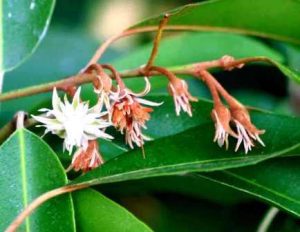
Mimusops zeyheri. Photo: Bart Wursten. Source: Flora of Zimbabwe
It was Red Milkwood Mimusops zeyheri that leaned over the water, uncommon in the catchment. Crossing to the opposite side of the river, one stride wide at this point, we saw how the floodwater had undercut the south bank and tall termite mound on which grew red milkwood and a stately Ebony Diospyros Diospyros mespiliformis with such a slender flange-shaped trunk; Ann had been up there to touch and clasp its trunk, she did not know that the ground was almost cut from under her feet.
A microclimate had developed here, the floods cut across the bend in the riverbed, alluvium has accumulated and the vegetation is verdant in the dry season. There was reed litter caught high up on bushes and piled on a flat boulder under the eroded bank. Higher, above the flood level, Croton, the most pleasing, presides over this botanical paradise.
Nearly home again, we walked the porcupine path down to the dam where the vlei margin dominated by coarse grasses, allows only a few African proteas and Broad-leaved Beechwood to survive there. The civet’s midden is on this route. In recent weeks a porcupine latrine seems to be forming, another quill was there.
Next time we will go to the wall on the north bank to view the whole length of the dam upstream, where it merges into kopjies, the Mvurwi Range of hills (Great Dyke) and the cloud effects. This is a memorable composition, a good illustration for these notes.
While writing these final paragraphs a White-faced Owl called, and then another responded, sometimes their voices mingled.
Thank you J.H.W for your piece in Tree Life No. 247 September 2000.
I.M.B.G. Tinto Raffingora 10-9-2000
-Benedicta Graves
ANDY MACNAUGHTAN CHAIRMAN


